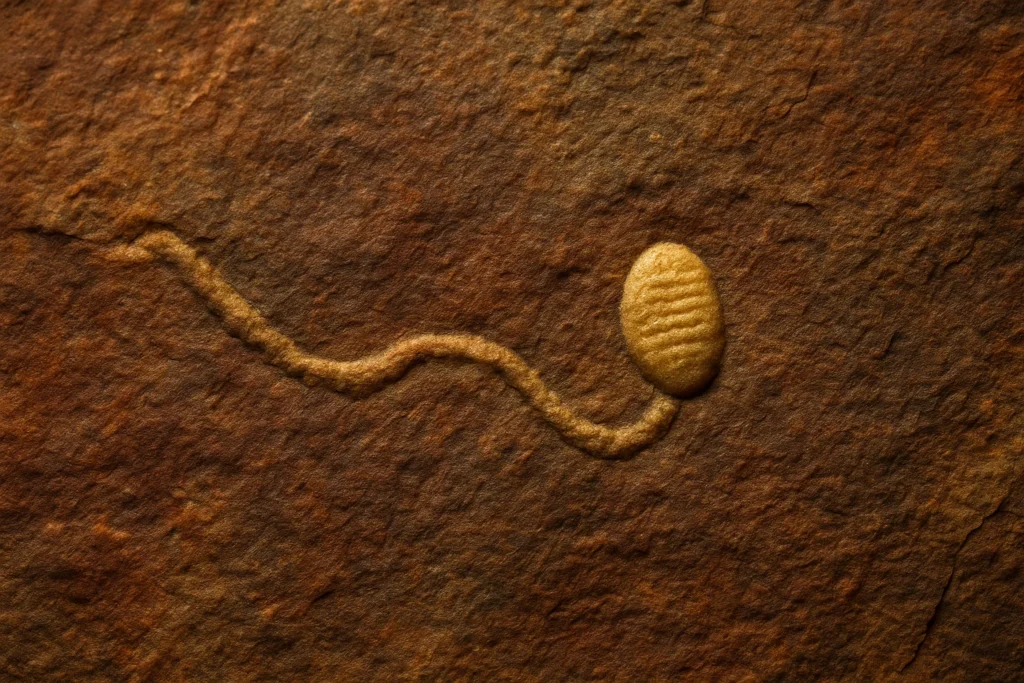Prologue: A Discovery That Shook the Scientific World
Dr. Scott Evans adjusted his wide-brimmed hat against the relentless Australian sun as he knelt in the rust-colored dirt of the Flinders Ranges. It was 2016, and his team from the University of California, Riverside had returned to these ancient hills – a geological wonder where 555-million-year-old seabeds now sit exposed to the open air. They were studying mysterious fossilized burrows from the Ediacaran Period, long before dinosaurs or even complex animals existed. But this time, Evans’ laser scanner revealed something extraordinary: faint but unmistakable impressions of the creature that made those burrows.
As the 3D image resolved on his tablet, Evans’ pulse quickened. There it was – Ikaria wariootia, the earliest known ancestor of virtually all animal life on Earth, preserved in stone. This microscopic worm-like creature, no larger than a grain of rice, would force scientists to completely rethink the timeline of animal evolution.
Chapter 1: The Eureka Moment in the Outback
Reading the Ediacaran Rosetta Stone
The discovery team, led by Dr. Mary Droser, had been studying the Nilpena fossil beds for over a decade. The site contains some of the best-preserved fossils from the Ediacaran Period (635-541 million years ago), when life was making the leap from simple single-celled organisms to complex animals.
Key breakthroughs that led to identifying Ikaria:
- Advanced laser scanning revealed subtle body impressions invisible to the naked eye
- 57 specimens identified, ranging from 2-7mm long (about the size of a sesame seed)
- Exceptional 3D preservation under layers of volcanic ash
- Associated burrows showed clear evidence of purposeful movement
“We weren’t finding bones or shells—we were finding ghosts. Shadows of the first creatures that moved under their own power. It was like discovering the very first footsteps ever taken.”
— Dr. Mary Droser, UC Riverside team leader
Why This Tiny Worm Matters
Ikaria represents several monumental firsts in evolutionary history:
✔ Oldest known bilaterian – ancestor of 99% of modern animals including humans
✔ Missing evolutionary link between simple organisms and complex life
✔ Proof that movement evolved 20 million years earlier than previously thought
✔ First evidence of centralized body organization in the fossil record
Chapter 2: Meet Your Greatest Grandparent
Anatomy of a Revolutionary
Through painstaking analysis, researchers reconstructed what Ikaria looked like and how it lived:
- Size: 2-7mm long (grain of rice to sesame seed size)
- Shape: Simple cylindrical body with distinct front and rear ends
- Movement: Used peristaltic contractions (wave-like muscle movements like modern worms)
- Senses: Likely had primitive light and chemical detection abilities
- Habitat: Burrowed through microbial mats on ancient seafloors
The Burrows That Changed Science
Ikaria’s fossilized tracks provide remarkable insights:
- Directed movement (not just passive drifting)
- Muscular control (peristalsis requires advanced biology)
- Environmental interaction (seeking food/oxygen)
- Behavioral complexity (evidence of decision-making)
Chapter 3: The World of Ikaria – Earth 555 Million Years Ago
Ediacaran Planet: A Strange New World
When Ikaria lived, Earth was profoundly different:
- Atmosphere: Only about 15% oxygen (vs 21% today)
- Climate: Emerging from global glaciation (“Snowball Earth”)
- Landscape: Completely barren – no plants or animals on land
- Seas: Dominated by strange fractal organisms like Dickinsonia
Why Ikaria Survived and Thrived
Several key adaptations gave Ikaria an evolutionary edge:
- Burrowing lifestyle protected from surface hazards
- Bilateral symmetry enabled more efficient movement
- Simple digestive system could process diverse food sources
- Muscular body allowed active hunting/foraging
Chapter 4: From Tiny Worm to Biological Revolution
Ikaria’s Lasting Legacy
This humble pioneer established body plans that would dominate Earth:
- Front/back orientation (basis for heads/tails)
- Muscle-based locomotion
- Centralized nervous systems
- Directed movement behavior
“Every vertebrate, every insect, every mollusk—they all share Ikaria as their last common ancestor. This tiny creature is the great-grandparent of nearly all complex life.”
— Professor Peter Vickers, evolutionary biologist
The Dawn of the Cambrian Explosion
Ikaria’s innovations set the stage for:
- Development of complex organs
- Evolution of predation
- Diversification of body plans
- The “Cambrian Explosion” of animal diversity
Chapter 5: Mysteries That Remain
Unanswered Questions About Our Ancient Ancestor
Despite this breakthrough discovery, many puzzles remain:
- Reproduction: How did Ikaria propagate its species?
- Diet: What exactly sustained these early animals?
- Evolutionary pressures: Why did bilateral symmetry become dominant?
- Earlier ancestors: What came before Ikaria?
Future Research Directions
New technologies may reveal:
- Molecular fossils preserved in the burrows
- Earlier transitional forms in older rock layers
- Better-preserved specimens showing soft tissues
- Behavioral evidence from trackway analysis
Epilogue: Perspective from the Field
As the sun set over the Flinders Ranges, casting long shadows across the fossil beds, Dr. Evans reflected on their tiny revolutionary:
“We came to this desert looking for clues about early life, never expecting to find the progenitor of nearly all animal life on Earth. Not bad for a worm you’d need a microscope to even see. It makes you wonder – what other evolutionary secrets are waiting in these ancient stones?”
Does knowing all complex animals share this microscopic ancestor change how you view the natural world? Share your thoughts below! 🐛🌍



